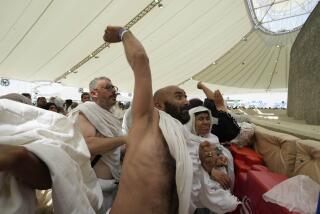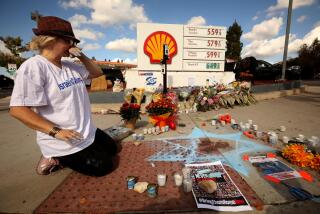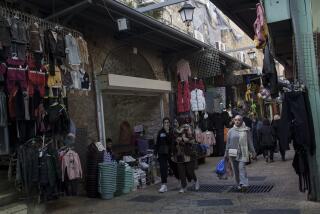Mecca’s ancient heritage is under attack
- Share via
MECCA, SAUDI ARABIA — These days it’s easier to find a Cinnabon in Mecca than the house where the prophet Muhammad was born.
The ancient sites in Islam’s holiest city are under attack from both money and religion. Developers are building giant glass and marble towers that loom over the Kaaba, Islam’s holiest site, which millions of Muslims face in their daily prayers. At the same time, religious leaders continue to work, as they have for decades, to destroy landmarks that they say encourage the worship of idols instead of God.
The two forces prompt some to complain that the kingdom’s religious austerity and oil-stoked capitalism are robbing this city of its history.
“To me, Mecca is not a city. It is a sanctuary. It is a place of diversity and tolerance. . . . Unfortunately it isn’t anymore,” said Sami Angawi, a Saudi architect who has devoted his life to preserving what remains of the area’s history. “Every day you come and see the buildings becoming bigger and bigger and higher and higher.”
Abraj al Bait is a complex of seven towers, some of them still under construction, rising only yards from the Kaaba, the cube-like black shrine at the center of Muslim worship in Mecca.
“Be a neighbor to the prophet,” says a newspaper ad for apartments there.
The towers are the biggest of the giant construction projects that have gone up in recent years, as the number of Muslims making the hajj, the annual pilgrimage to Mecca, has swelled, reaching nearly 4 million last year. Saudi Arabia is trying to better serve the growing upscale end of the pilgrimage crowd, while investors -- many of them members of the Saudi royal family -- realize the huge profits to be made.
Saudi Arabia boasts that Abraj al Bait -- Arabic for Towers of the House, referring to the Kaaba’s nickname, “the House of God” -- will be the largest building in the world in terms of floor space. Developers have said the completed building will total 15.6 million square feet -- more than twice the floor space of the Pentagon, the largest in the United States.
Three of the towers, each nearly 30 stories, are complete, and the others are rapidly going up. A mall at their base has opened, where customers -- many in the white robes of pilgrims -- shop at international chains such as the Body Shop and eat at fast-food restaurants. Other nearby complexes include upscale hotels.
The building boom is in some cases destroying Mecca’s historic heritage, not just overshadowing it. In 2002, Saudi authorities tore down a 200-year-old fort built by the Ottomans on a hill overlooking the Kaaba to build a multimillion-dollar housing complex for pilgrims.
The holy sites also have been targeted for decades by the clerics who give Saudi Arabia’s leadership religious legitimacy. In their puritanical Wahhabi view, worship at historic sites connected to mere mortals -- such as Muhammad or his contemporaries -- can easily become a form of idolatry. (Worship at the Kabaa, which is ordered in the Koran, is an exception.)
“Obviously, this is an exaggerated interpretation. But unfortunately, it is favored among officials,” said Anwar Eshky, a Saudi analyst and head of a Jiddah-based research center.
The house where Muhammad is believed to have been born in 570 now lies under a rundown building overshadowed by a giant royal palace and hotel towers. The then-king, Abdulaziz, ordered a library built on top of the site 70 years ago as a compromise after Wahhabi clerics called for it to be torn down.
Other sites disappeared long ago, as Saudi authorities expanded the Grand Mosque around the Kaaba in the 1980s. The house of Khadija, Muhammad’s first wife, where Muslims believe he received some of the first revelations of the Koran, was lost under the construction, as was the Dar al Arqam, the first Islamic school, where Muhammad taught.
At Hiraa Cave, where Muhammad is believed to have received the first verses of the Koran in the mountains on the edge of Mecca, a warning posted by Wahhabi religious police warns pilgrims not to pray or “touch stones” to receive blessings.
In Medina, 250 miles north of Mecca, Muhammad’s tomb is the only shrine that survived the Wahhabis, and a mosque has been built around it. But religious police bar visitors from praying in the tomb chamber or touching the silver cage around it.
“You shouldn’t do that,” a policeman tells pilgrims trying to pray at the site.
Outside the Prophet’s Mosque, Wahhabis have destroyed the Baqi, a large cemetery where tombs of several of the prophet’s wives, daughters, sons and as many as six grandsons and Shiite saints were once located. Grave markers have been bulldozed, and religious police open the site only once a day to let in male pilgrims. The visitors are prevented from praying.
“It is pretty sad that our imams do not even have tombstones to tell where they are buried,” said Indian pilgrim Zuhairi Mashouk Khan, who was weeping because he was barred from praying at the site. “They deserve a shrine as monumental as Taj Mahal.”
Several Islamic groups, such as the Britain-based Islamic Heritage and Research Foundation and the U.S- based Institute for Gulf Affairs, are campaigning to restore ancient sites. Khaled Azab, an Egyptian expert on Islamic heritage at the Bibliotheca Alexandria, suggests that the Saudi government bring in UNESCO to help.
But after years of campaigning, Angawi is on the verge of giving up.
“I have been saying this for 35 years but nobody listens,” he said. “It is becoming a hopeless case.”
More to Read
Sign up for Essential California
The most important California stories and recommendations in your inbox every morning.
You may occasionally receive promotional content from the Los Angeles Times.










